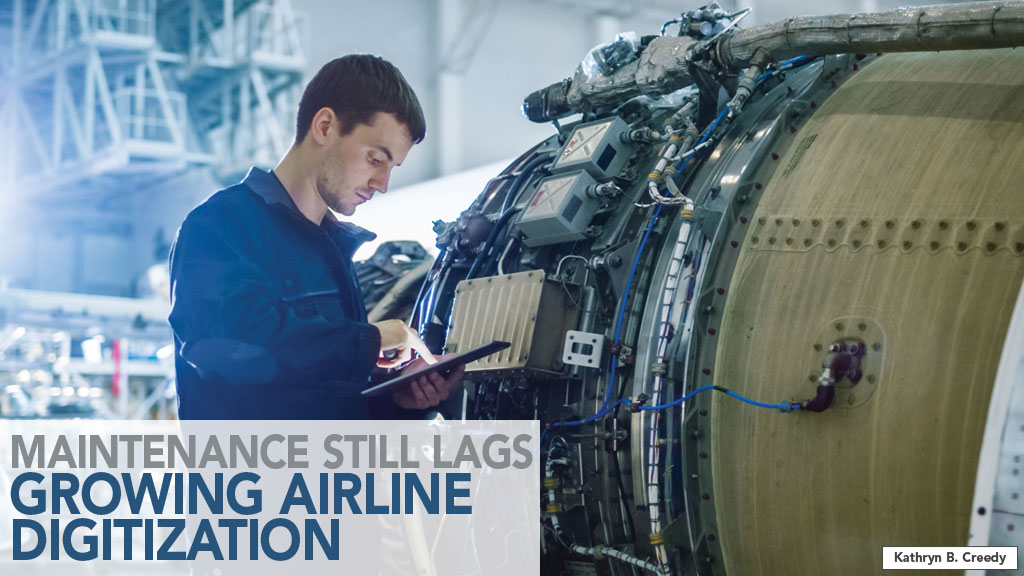While airlines continue the process of digitization, industry observers indicate maintenance is lagging the effort that could save millions of dollars while increasing productivity and increasing safety. This is surprising given the fact how fast manufacturers have integrated digital data from everything on board from inflight entertainment systems to engines which stream tons of data every minute.
“When you consider that 20 years ago means 2001, we can confidently reflect on some of the innovations and leaps forward we have made within the aviation industry,” flydocs CEO Andre Fischer told Aviation Maintenance. “However, when looking more specifically at technical records, progress has been slower. Huge leaps have been made by the aviation sector in implementing high-tech technology to improve passenger experience and make the journey much more feasible. It comes as quite a surprise that the technical and MRO side of the aviation sector still has so many paper-based processes, especially when it comes to managing technical records. Shifting to paperless is slow but we are starting to see a real mindset change for digitally driven solutions, with the pandemic giving this area a bit of a boost. As the world locked down, the ability to access records with fewer challenges started to become a priority for many operators, lessors and MROs.”
The other factor at play is fleet growth. “Digitization of records keeping is one the major changes in the technical records area,” Saravanan Rajarajan, director — aviation consulting, Ramco Systems told Aviation Maintenance. “This can be attributed to two main factors one is growth of the aircraft fleets over the last 20 years which makes the manual processing of records inefficient and the second is evolving technologies in the MRO space to digitize the data entry like electronic tech logs, mobile-based maintenance execution and the availability of technical manuals in digital format. Recent developments on remote collaborations and virtual inspections have stretched the boundaries of the technical records to manage new forms of the data like voice and videos with ability to archive and audit for regulatory purposes.”
Fischer explained since the industry entered recovery mode, it is taking time for airlines to realize the true potential and accelerate this push towards digital solutions.
“There is huge optimism though as some airlines are seeing this crisis as an opportunity to drive their digital transformation forward, which not only creates a competitive advantage but plays a role in minimizing the risks of another global game-changer like the global pandemic,” Fischer said. “While the industry is seeing the value of digitization, the lag is experienced more on the engineering side where adoption of change is a bit slower. The balance between trying to achieve 100% operational safety on the engineering side and new developments in technology is very tricky so needs to be managed very carefully to bring out the best of both sides.”
Fischer noted the lack of standardization is playing a role in slow adoption. “Regulators could play a huge role in developing standardized frameworks and committing to supporting digital initiatives to ensure that every segment of the aviation industry reaps the rewards of digitization,” he said.
Record Keeping Maintains Asset Value
Nothing brings the value of an aircraft down faster than lousy record keeping as anyone who has every maintained or tried to sell an aircraft knows. In aviation, forcing an aircraft inspector to root through mildewed boxes to reconstruct the maintenance history quickly brings the value down to zero or the cost of reconstructing those records into the hundreds of thousands.
“MROs can also benefit from more efficient ways to review maintenance records,” said Fischer. “The convenience and improved efficiency of being able to access maintenance records instantly in one centralized location from anywhere in the world already has a positive impact. Moving away from having stacks of documents being stored off-site brings a high risk of loss and damage. That risk is completely eliminated with digital records. From a business continuity perspective, COVID-19 proved that digital access of records is invaluable and drives cost savings. “
For airlines, record keeping is the difference between airworthiness and grounding of an aircraft or a fleet. Just recently, DGAC grounded Air Antilles fleet for aircraft maintenance irregularities stranding its passengers scattered among the French islands in the Caribbean. Indeed, for airlines, the issue is not only about record keeping but the efficiency of doing so as part of efforts to ensure compliance and safety and cut costs.
“It’s not uncommon to see a value of aircraft drop by 20% due to the missing records during business transactions,” Rajarajan told Aviation Maintenance. “Records management also provides the insights needed for the organizations to optimize the maintenance intervals based on their operating environments. With the majority of the items fitted on aircraft on condition and subject to rotate between the aircraft, records management becomes vital to track the configurations control, component status, hours and cycles.
“The technical records department spends considerable effort and time whenever they deal with paper-based documentation to manage error correction, reviewing the accuracy, scanning and archiving,” Rajarajan continued. “Efforts tend to be significantly higher if the organization doesn’t have a proper technical records system in place. We have seen pursuing a comprehensive technical records digitization process organization can save 40% of the department expenses owing to automation of manual process at the organizational level. The rapid progress and maturity of mobile technologies and digital content availability of technical documentation including manuals and job cards, has made the shop floor digitization a reality.”
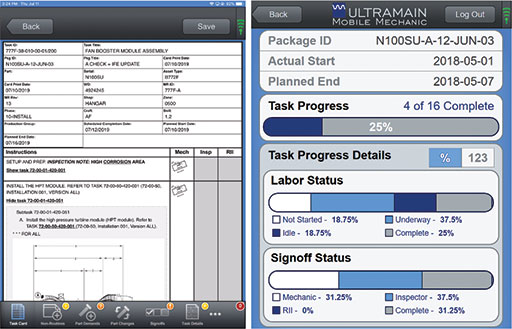
John Stone, Ultramain vice president of Product Management agrees. “Airlines are required to maintain detailed records of aircraft usage, and aircraft maintenance including any changes made to aircraft, configurations and components,” he told Aviation Maintenance. “MROs are required to provide records of maintenance accomplished. If airlines do not comply or do a poor job of record management, they can face fines and forced closure. Aircraft resale value and lease returns are impacted by having or not having good maintenance records. Equally important, good data collection related to maintenance accomplishments allows better accomplishment of future maintenance through better planning, scheduling and contingency planning.”
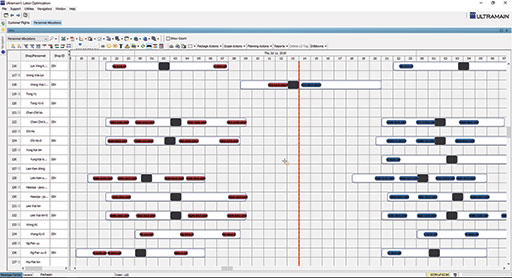
Even when an aircraft is parted out, record keeping is a major part of the equation as evidenced by the fact record keeping, inspecting and refurbishing are part of realizing the value of parts that can be re-used. For instance, Tarmac Aerosave and VAS Aero Services are breaking down former Singapore Airlines Airbus A380s for owner Dr. Phillips Group as they recycle 90% of the giant jumbo. Paperwork — written and photographic documentation — for the 5,000 parts harvested from the aircraft can take a month or more of the three or more months aircraft recycling takes. But the effort could yield between $30 million and $50 million for the owners.

Vice President, Ultramain
Industry Slow to Go Paperless
Today, with modern aircraft streaming tons of data, it has become more important than ever to integrate Artificial Intelligence (AI) and Machine Learning (ML) into the process and aviation maintenance vendors such as RAMCO, flydocs and Ultramain are bringing the technology to bear. They are all part of the digital transformation taking place in the maintenance bay supporting paperless operations.
flydocs reported digital document management systems are playing a huge role in streamlining maintenance activities. “What these digital systems often have in common is in the increased visibility of an aircraft’s entire maintenance records, easy online access and more importantly, reporting functionality that contains all the required insights,” Fischer advised. “It also enhances fleet airworthiness, allowing customers to focus time and resources on the core business.”
He discussed how flydocs’ records management platform is transforming how the commercial aviation sector undertakes end-to-end aircraft records management whilst delivering substantial efficiencies and cost savings for its 75 clients worldwide.
“The flydocs team help clients improve processes, driving time and cost efficiencies through digital aircraft records management,” he said. “They are empowered by the flydocs platform, a centralized online system, which provides internal and authorized third parties with instant access to millions of approved aircraft records for compliance verification. The system transforms complex, unstructured data into industry-standard formats; and through integration with existing ERP/M&E systems, it automates and streamlines record builds to provide the right information exactly when they need it, resulting in compliance on demand, simplified end-of-lease transfers and real-time asset management.”
Sea Change Unfolding
Airlines are already incentivized to adopt digital solutions to unlock the value through the end-to-end digitization process because, as Stone pointed out, the improved productivity, reduced operational costs and reduced overhead compared to traditional paper-based record keeping system which is more costly. Ultramain has two product divisions, M&E/MRO and Onboard Systems each designed for full paperless operations using the ULTRAMAIN ELB software to address a broad spectrum of aviation maintenance needs. including maintenance (line, base, engine, shop) with materials, labor, documentation, ELB and procurement. Complementing this is several mobile applications including Mobile Mechanic, Mobile Inventory and Mobile Executive, which help streamline workflow, reduce costs and improve operational efficiencies. The system provides real-time maintenance work status and completion.
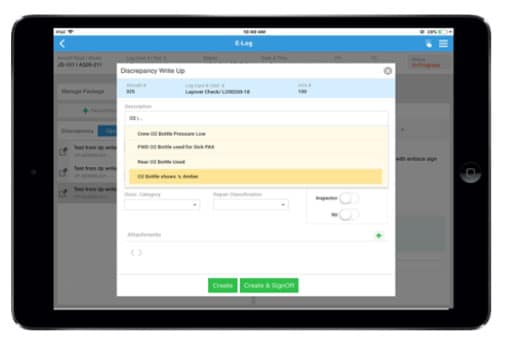
“This real-time visibility into work being performed, coupled with digital sign-off is important because it helps operators by reducing the delays associated with paper-based systems,” said Stone. “Meanwhile, our ULTRAMAIN Labor Management ensures engineers are current, certified, and qualified to perform the tasks assigned to them. It does not let them log onto a task unless they are. In fact, ULTRAMAIN will not let you even assign a task to someone who is not qualified to perform it and it will not let engineers sign off tasks unless they have proper authority, improving safety and accountability. In addition, NRI approvals and billing agreement is enforced before allowing work to begin on them.”
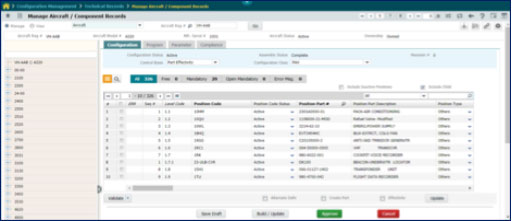
flydocs also sees digital maintenance record keeping as supporting airline growth in addition to improved compliance on demand, improved agility to adapt to operational business process changes, increased workforce productivity, job satisfaction and a reduction in aircraft delays.
Benefits include automation of manual and repetitive tasks and integration with the entire aviation eco-system easing the workload for operators, lessors and MROs. “Routine and repetitive back-end activities are being automated to detect the exception patterns and provide intelligent real-time alerts and notifications,” Stone explained. “As the data are entered in the digital format missing sign off blocks, missing mandatory measurement readings are instantly identified for rectification. With the interdependence in the industry between the lessors, operators, MRO’s to work seamlessly with one another’s digital records enables interoperability thereby reducing the transactional costs during the asset transfers.”
Stone indicated the real-time notifications identifies when delays are happening during maintenance checks so they can be addressed quickly and to ensure customers get their aircraft, engines or components back on time, with correct electronic paperwork and with proper billing which speeds up payment.
“All this means check planning, quoting, execution, records are better and expenses lower,” he said. “Profitability is then managed and more predictable.”
AI & ML Brought to Bear
“RAMCO’s artificial intelligence and machine learning (AI/ML) capabilities leverages data and advanced algorithms to derive insights for tactical intelligence,” said Rajarajan. “By leveraging the historical records pertaining to the non-routine or defect, mechanics, while reporting a new case, are presented with the suggestions using similar cases with possible resolution options and any parts or tools required for fixing the defect. Final determination of accepting the recommendations still lies with the mechanics, even though this is tactical insight it has the potential to significantly reduce turn-around time especially during unplanned grounding of the aircraft.”
Ramco has the comprehensive technical records functions tightly integrated with maintenance execution modules, providing a single interface, technical records hub, which caters to the technical records teams. That hub then provides the complete visibility of the aircraft configuration control, component configuration and status of the fitted items and items due for maintenance from stores.
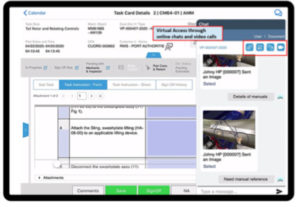
The advent of both voice and video gives aviation maintenance technicians a new tool to record data that automatically integrates records as part of the technical documentation, tagged, indexed and archived for future search, retrieval and audit purposes.
Leveraging RAMCO’s expertise of its MRO Lab in Singapore, RAMCO is actively working with customer’s specific use cases leveraging Robotic Process Automation (RPA) Bots for missing paperwork, missing data entry and accuracy reviews.
As M&E/MRO catches up to the passenger side of digitization, airlines, which continue to search for cost cutting technologies, are creating a whole new world for asset management.
